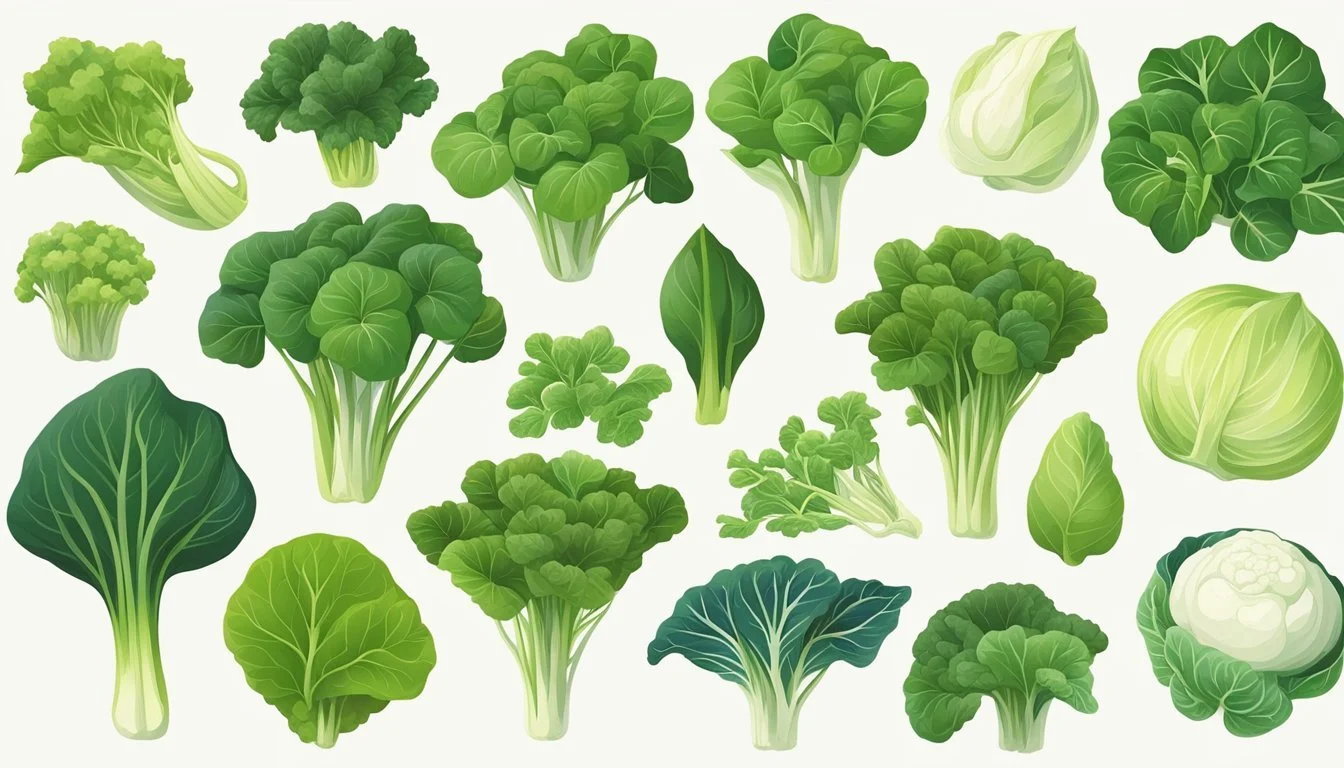Tatsoi Substitutes
Best Alternatives for Your Recipes
Navigating recipes that call for tatsoi can sometimes be a challenge when this unique green isn't available. Tatsoi, also known as spinach mustard, offers a delicate, slightly mustard-like taste that enhances a variety of dishes. This versatile green works well in salads, soups, and stir-fries, making it a crucial element in many kitchens.
For those seeking substitutes, there are several greens that can fill in when tatsoi is out of reach. Spinach and bok choy often come first to mind due to their similar texture and flavor profiles. Each provides a different twist, yet maintains that tender and leafy consistency tatsoi lovers cherish.
Kale also serves as a robust alternative, bringing a bit more texture and an earthier flavor to the mix. The sturdiness of kale leaves allows it to retain shape and substance in cooked dishes, ensuring that the absence of tatsoi doesn’t compromise the dish’s overall structure.
Understanding Tatsoi
Tatsoi is a leafy green with dark green leaves that is both nutritious and versatile. Known for its mild mustard-like flavor, tatsoi is an excellent source of vitamins, minerals, and fiber.
Origins and Characteristics
Tatsoi, a member of the Brassica family, is often compared to spinach in terms of texture and culinary use. This cruciferous vegetable, also known as Brassica rapa subsp. narinosa, has spoon-shaped leaves and a mild, slightly sweet flavor.
Originally cultivated in China during the 6th century, tatsoi made its way into various Asian cuisines. Its smooth, creamy texture and subtle peppery notes enhance salads, soups, and stir-fries. The name "tatsoi" derives from Japanese, translating to "green onion leaf." Its adaptability in both raw and cooked forms makes it a popular choice among chefs and home cooks alike.
Nutritional Profile
Tatsoi is rich in nutrients, making it a valuable addition to a healthy diet. It is particularly high in vitamins A and C, which are crucial for immune support and skin health. Additionally, it provides significant amounts of calcium, potassium, and magnesium—essential minerals that aid in various bodily functions.
This leafy green is also a good source of dietary fiber, promoting digestive health and satiety. With its low calorie content, tatsoi is an excellent choice for those looking to maintain or lose weight while obtaining essential nutrients. Its combination of vitamins, minerals, and fiber underlines its status as a highly nutritious vegetable.
Common Uses of Tatsoi in Cooking
Tatsoi is a versatile green widely used in various culinary applications. Its mildly sweet, earthy flavor and tender texture make it a popular ingredient in salads, stir-fries, and soups.
Salads and Raw Preparations
Tatsoi’s spoon-shaped leaves are perfect for adding a fresh, crisp texture to salads. Often compared to spinach and bok choy, tatsoi offers a mild flavor that pairs well with other greens like arugula and mizuna.
In raw form, tatsoi retains its vibrant green color and provides a rich source of vitamins A and C. It can be the base of a salad or a supplementary green in mixed salads.
Adding elements like nuts, fruits, and cheese can enhance the overall flavor profile. For a traditional Asian touch, tatsoi can be combined with sesame seeds and a light soy-sesame dressing. Its versatility makes it an excellent choice for both simple summer salads and more elaborate composed salads.
Stir-Fries and Cooked Dishes
Tatsoi is highly valued in stir-fries for its ability to maintain texture and nutritional value even when lightly cooked. It’s often used in Asian cuisine, serving as a substitute for bok choy in various dishes. When stir-fried, it becomes tender but retains its crunch, making it a dynamic ingredient.
Sautéing tatsoi with garlic and ginger highlights its flavor. A quick toss in a hot wok enhances its natural sweetness without losing its nutrients. Adding a splash of soy sauce or fish sauce can deepen the flavor.
Besides stir-fries, tatsoi can be added to omelets, pasta dishes, or even as a topping for pizzas. Its adaptability makes it an integral ingredient in many quick and nutritious meals.
Soups and Broths
In soups and broths, tatsoi imparts a subtle, earthy flavor while adding a bright green contrast. It’s commonly added to Asian soups, such as bok choy soup, lending its tender leaves and nutritional benefits.
Whether in a clear broth or miso soup, tatsoi’s delicate texture softens quickly, making it an excellent last-minute addition. Its high vitamin C content is especially beneficial in broths where nutrients can be easily retained.
Adding tatsoi to chicken noodle soup, vegetable broths, or ramen enhances the dish’s visual appeal and nutritional profile. For an extra burst of flavor, pair tatsoi with ingredients like mushrooms, tofu, and scallions.
Tatsoi's versatility in various cooking methods and dishes makes it an invaluable green in the kitchen.
Tatsoi Substitutes: Leafy Greens
For those seeking substitutes for tatsoi, there are several leafy greens that can fit well into various recipes. Key alternatives include spinach, kale, Swiss chard, mustard greens, and bok choy.
Spinach: A Versatile Alternative
Spinach stands out as a widely used substitute due to its versatility. It can be eaten raw in salads or cooked in a variety of dishes. Spinach leaves are tender with a mild taste, making them suitable for many cuisines. Nutritionally, spinach is rich in iron, vitamins A and C, and folate. Its adaptability allows it to replace tatsoi with minimal impact on flavor profiles.
Kale: The Nutrient-Rich Choice
Kale offers a robust, slightly bitter taste that differs from tatsoi's mild flavor but provides a healthy alternative. It's packed with nutrients, such as vitamins A, C, K, and calcium. Kale can be used in salads, soups, and stir-fries. Though it has a tougher texture, massaging kale with a bit of oil can make the leaves more palatable when used raw.
Swiss Chard: Colorful and Flavorful
Swiss chard is known for its vibrant stems and large, dark green leaves. It shares some similarities with tatsoi, particularly in its slight bitterness and nutrient content. Swiss chard is often used in sautés, soups, and stews. It provides an excellent source of vitamins A and K, along with magnesium and potassium, adding both a visual and nutritional boost to dishes.
Mustard Greens: For a Peppery Kick
Mustard greens offer a distinct peppery flavor, adding a spicy kick to any meal. They are ideal for those who prefer a more pronounced taste than tatsoi. Rich in vitamins A, C, and K, as well as calcium and fiber, mustard greens can be used in salads, stir-fries, and braised dishes. Their bold taste enhances various recipes, providing a unique alternative.
Bok Choy: The Closest Match
Bok choy is perhaps the most similar substitute to tatsoi, both in flavor and texture. Its tender, dark green leaves and crisp white stems make it a versatile green suited for both raw and cooked applications. Bok choy is rich in vitamins A, C, and K, as well as calcium. It can seamlessly replace tatsoi in salads, soups, and stir-fries, making it an excellent choice for those seeking a like-for-like alternative.
Tatsoi Substitutes in Asian Cuisine
When Tatsoi is unavailable, several other leafy greens can effectively replace it in Asian dishes. These substitutes maintain the balance of flavor and texture that Tatsoi offers, ensuring your culinary creations remain delicious and authentic.
Chinese Broccoli: A Flavorful Stand-in
Chinese Broccoli, or Gai Lan, offers a slightly bitter, earthy flavor similar to Tatsoi. Common in stir-fries and soups, it balances well with savory sauces like oyster or soy. Its thick stems provide a delightful crunch, and the dark green leaves hold up well to various cooking methods. For best results, blanch briefly before stir-frying to retain color and texture.
Napa Cabbage: Mild and Crunchy
Napa Cabbage boasts a mild taste and a pleasant crunch. Its tender leaves and crispy white stems make it a versatile substitute. Frequently used in soups and hot pots, Napa Cabbage absorbs flavors well and can be a great addition to dumplings and kimchi. Sauté or steam it lightly to enjoy its firm yet tender texture.
Pak Choi and Choy Sum: Smaller Variants
Pak Choi (Bok Choy) and Choy Sum are smaller Asian greens with mild flavors, making them excellent Tatsoi substitutes. Pak Choi’s white stems and green leaves offer a crunchy, yet tender bite, ideal in stir-fries and broths. Choy Sum is similar but with a slightly sweeter stem. These greens work well in dishes where a light, fresh crunch is desired.
Yu Choy: The Leafy Substitute
Yu Choy has tender, slightly sweet leaves and thin stems that can stand in for Tatsoi. Integral to many Chinese dishes, Yu Choy is often stir-fried with garlic or added to soups for a subtle, earthy flavor. Lightly cooking Yu Choy preserves its vibrant green color and enhances its natural sweetness, making it perfect for both side dishes and main courses.
Non-Leafy Tatsoi Substitutes
Non-leafy substitutes for tatsoi can provide a similar taste profile or a contrasting texture that complements various dishes. These alternatives can be used in a range of recipes, offering versatility and nutrition.
Broccoli and Chinese Broccoli
Broccoli and Chinese broccoli are excellent non-leafy substitutes for tatsoi, especially in cooked dishes. Broccoli's florets offer a slightly sweet, earthy flavor, making them a good match for stir-fries and soups.
Chinese broccoli, also known as gai lan, has a bitter taste with a mild sweetness, similar to tatsoi. It is perfect for Asian-inspired recipes, providing a robust flavor that stands up well to strong sauces and seasonings. Both vegetables can be steamed, sautéed, or roasted, enhancing their natural flavors.
Celery and Leek: Adding a Crunchy Texture
Celery and leek are ideal choices when a crunchy texture is desired. Celery offers a fresh, crisp bite, making it suitable for salads and raw applications. Its mild, slightly peppery flavor can complement dishes where tatsoi's texture is sought after but with added crunch.
Leek, with its mild, onion-like flavor, provides a unique twist in recipes that call for a more aromatic substitute. Leeks can be sautéed, braised, or used in soups and stews to introduce a subtle sweetness and depth of flavor. Additionally, leeks are versatile in that they can add both texture and a nuanced taste to a variety of dishes.
Tatsoi Substitutes for Specific Dishes
When replacing tatsoi in your recipes, consider the use, cooking method, and taste profile to find a suitable substitute that complements various dishes.
Substitutes for Fresh and Raw Tatsoi
For salads and other raw dishes, spinach is a perfect substitute for tatsoi. Its mild taste and tender leaves make it versatile.
Arugula offers a peppery kick and can add a unique flavor to fresh preparations. Mizuna, another Asian green, has a similar texture and works well in mixed greens salads.
Baby kale also fits for a robust, slightly earthy taste. These greens maintain the vibrant freshness needed in raw dishes.
Best Alternatives for Cooked Tatsoi
When cooking, consider the texture and cooking time. Bok choy is an excellent replacement due to its similar texture and slight bitterness. Swiss chard is another great option, especially for stir-fries and sautés.
Napa cabbage can also work well for its mild flavor and tender leaves.
Collard greens can be used, but expect a longer cooking time to achieve the desired tenderness. Spinach is another option, though it wilts rapidly and has a milder profile.
Making Substitutions in Asian Soups
Asian soups benefit from greens that can withstand simmering. Bok choy is a top substitute, maintaining its shape and slight crunch. Napa cabbage is also a good choice, offering a mild taste without overpowering the broth.
For a slightly different flavor, choy sum and tatsoi can stand in, providing a similar texture and appearance. Spinach is acceptable for a delicate touch, though it will wilt more quickly.
These substitutes ensure the soup remains hearty and nutritious, preserving the essence of the original dish.
Selecting and Storing Tatsoi Substitutes
When selecting substitutes for tatsoi, consider factors such as flavor, texture, and nutritional benefits. Proper storage techniques are essential to maintain freshness and maximize shelf life.
How to Choose the Best Alternatives
Choosing the best substitutes for tatsoi involves considering similar leafy greens. Spinach offers a mild flavor and is packed with vitamins A and C. Bok choy provides a similar texture with a slightly stronger flavor, offering a good amount of vitamin K and calcium. Arugula has a peppery taste and is high in potassium and folate, making it an excellent choice for salads.
Swiss chard is another great alternative, known for its mild taste and rich nutrient profile, including vitamins A, K, and C. Kale, with its robust flavor and high fiber content, is also a viable substitute. Napa cabbage can work in cooked dishes, bringing a crisper texture and subtler taste than some of the other greens.
Proper Storage Techniques
Proper storage is crucial for maintaining the freshness of tatsoi substitutes. For spinach and arugula, wrap the leaves in a damp paper towel and place them in a plastic bag. Store in the refrigerator to keep them fresh for up to a week. Bok choy and Napa cabbage can be stored in perforated plastic bags in the crisper drawer to stay fresh for 4-5 days.
Swiss chard and kale should be kept in airtight containers or plastic bags in the refrigerator. Wait to wash the leaves until just before use to prevent excess moisture that can cause spoilage. Ensuring proper storage not only extends shelf life but also preserves the nutritional integrity of these leafy greens.







